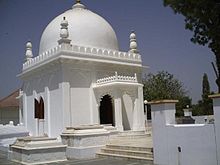Abdallah (Ismaili missionary to Gujarat)
| Part of a series on Islam Isma'ilism |
|---|
 |
|
|

Moulai Abdullah[1][2][3][4][5] (Template:Lang-ar) was the first Ismaili, Fatimid, mustaali saint who came to Cambay (Khambat), Gujarat in India in about 1067 AD (460AH) from Haraz Mountains, Yemen. Syedi Nuruddin was his companion who also visited Imam Al-Mustansir Billah, Egypt. He joined the Ismaili faith under Fatimid Dai Mu'ayyad fi'l-Din al-Shirazi, and came back to Khambat, India to propagate the Taiyabi faith. His earlier name was Balam Nath.[6]
He is said to have stayed some years at Cambay studying the people. He died on August 12, 1141 in Khambhat, Gujarat, India and his mausoleum is located there.
According to a legend, a da'i named Ahmad once took two the Gujarati orphans (Abdullah and Nuruddin) to Cairo, trained them in the Ismaili doctrine, and sent them back to Gujarat as missionary. Abdullah laid the foundation of the Bohra community.[7] According to the Bohra myths, Jayasimha sent an army to capture Abdullah, but Abdullah converted him to Islam by performing miracles and by exposing the purported miracles of Hindu pandits as fake. There is no evidence that Jayasimha ever gave up Shaivism, but several of the Bohra Walis and Da'i al-Mutlaqs claimed descent from him.[8] These included Syedna Ismail, the 34th Da'i al-Mutlaq.[9]
Two stories are told of his first missionary success. According to one story, he gained a cultivator's heart by filling his dry well with water. As per second he travelled to Ahlinvada, Patan. King Sidhraj Jaisingh sent a force of armed men to fetch him, found surrounded with wall of fire. King himself went there to meet him. Later on two of his minister Tarmal and Bharmal became his follower.
Syedi Hasan Feer, 14th century famous saint at Sultan of Patan was also from the lineage of Maulaya Abdullah.[10]
References
- ^ Enthoven, R. E. (1922). The Tribes and Castes of Bombay. Vol. 1. Asian Educational Services. p. 199. ISBN 81-206-0630-2.
- ^ The Bohras, By: Asgharali Engineer, Vikas Pub. House, p.109,101
- ^ [1]; www.geni.com/people/Maulai-Abdullah.
- ^ [2]; p.33; ‘act of al Mustansir was sending missionaries to Gujarat’
- ^ Survival Amidst Fatimid Collapse; The Ismaili da'wa Outside the Fatimid dawla, by Daftary, F. "The Ismaili da'wa Outside the Fatimid dawla," in L'Egypte Fatimide: Son Art et Son Histoire, Marianne Barrucand (ed.) pp. 29 - 43. Paris: Presses de l'Universite de Paris-Sorbonne; ‘around 460AH/1067AD, Yamani da`is were dispatched to Gujarat under the close supervision of the Sulayhids’
- ^ [3] 12.0 The Fatimid Da'i Al-Mu'ayyad: His Life , by: Dr. Abbas Hamdani, University of Wisconsin, Milwaukee (U.S.A.): "The spread of the Da'wa in Deccan and its origin in al-Mu'ayyad is mentioned by Khwaj b. Malik in his Majmu' (p. 1 3) as follows:' In the district of Deccan there is a village called Daham Gam. lman (faith) spread in this district from this village, just as in Gujarat it spread from Cambay. In this village there were two .men who acquired knowledge, then proceeded from India, in the time of al-Mustansir, to Egypt and joined the lsma'ili faith at the bidding of Sayyidna al-Mu'ayyad from whom they acquired much knowledge. Their names were (Ba)Lam Nath(known as Moulai Abdullah) and Rup Nath (later called Mawla'i Nurad-Din). Both of them returned from Egypt to their native village, (Khambat(Cam Bay, and) Daham Gam(near Aurangabad), where their tombs still exist near Aurangabad."
- ^ Jonah Blank 2001, p. 37.
- ^ Jonah Blank 2001, p. 38.
- ^ Jonah Blank 2001, p. 44.
- ^ [4] Archived 2017-02-08 at the Wayback Machine, syedi-hasanfeer-shaheed-qs
